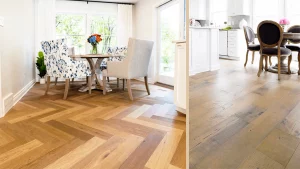
Sheet vinyl flooring has been considered the best choice, especially when it comes to places with moisture. Resistant to water damage and stains, vinyl flooring is still a favourite material for bathroom, kitchen, basement, and hall floors.
However, standard vinyl is constructed of a very thin layer of vinyl printed with a pattern layer and covered with a protective coating. It is prone to gouging and tearing and can be rather hard to walk on, particularly if laid over concrete.
To overcome those existing issues, manufacturers created a new type of vinyl flooring – luxury vinyl flooring or LVF. It can be found in the form of planks (LVP) or tiles (LVT). It is installed with the same click-lock interlocking edges as the laminate flooring. In fact, if they don’t go with higher quality (and more expensive) hardwood, ceramic, or stone tiles, many customers are left contemplating luxury vinyl vs. laminate as second-tier options.
Many people have to choose between vinyl and luxury vinyl. Luxury vinyl flooring, like normal vinyl flooring, has advantages and disadvantages. While they are fundamentally the same material, there are significant distinctions between vinyl and luxury vinyl. Here’s what you need to know to make an informed decision.
Structural differences between standard and luxury vinyl flooring
Regular vinyl flooring is often provided in either flexible sheets or square tiles. A thin backing layer of felt or fibreglass is glued to a thin layer of solid vinyl in standard vinyl. This vinyl layer is printed with a design and then protected with a clear coating. This type of vinyl is a flexible and thin material.
In the meantime, luxury vinyl flooring is a different sort of flooring, despite the fact that it is manufactured of the same PVC vinyl as the conventional type. Luxury vinyl is available in multi-ply planks or tiles with wear layers ranging in thickness from 2 to 8 mm. This makes it a lot thicker – it is made of 6-8 layers of materials including a clear top-coat layer for shine, a transparent wear layer to protect the design, a design layer with the printed image, a foam cushion layer to make the floor comfortable to walk on, a fibreglass backing layer, and a solid PVC backing layer for strength and rigidity.
Differences in the appearance of the two
Standard vinyl is often designed to look like ceramic or stone tiles. It can be found in many designs and colours, including the popular style that looks like wood. However, because the layer of vinyl is thin and smooth, the simulated cracks between the tiles or wooden planks are often not so convincing.
Luxury vinyl planks are often made to look like wood, similar to laminate flooring. Luxury vinyl tiles are usually simulating stone or ceramic tiles. Since the material is a lot thicker, the surface can be quite convincing, making it hard for the customers to pick between vinyl and laminate flooring. In general, luxury vinyl is better when it comes to looks. They are a lot more convincing and ass the durability of vinyl to the good looks.
Water and heat resistance differences
In general, both types of vinyl are waterproof and a great choice when it comes to bathroom, kitchen, basement, and entrance flooring.
Standard vinyl sheeting is a water-repellent material. Sheets contain fewer gaps than planks or tiles, which could allow water to enter the flooring. This type of vinyl flooring is better when it comes to water resistance. If this feature is a priority in the area that you are renovating, we suggest you pick the regular sheets of vinyl.
Luxury vinyl flooring is initially made of the same materials, however, one of the few problems with luxury vinyl tile is the seams between the tiles (or planks) that make it possible for water to seep down to the underlayment.
Both varieties of vinyl flooring can withstand regular heat, such as direct sunshine, but they cannot withstand excessive heat. This is not a recommended flooring material to put behind a water heater or near a furnace. Also, make sure to avoid dropping hot skillets or heating appliances on it.
Cleaning and maintenance differences
Both types of vinyl are extremely easy to maintain and clean. Their synthetic nature and water damage resistance make cleaning very easy. Spills and stains can be wiped with a simple mop and a bit of cleaning solution. Mop the floor every week or so with warm (not hot) water and a light soap. Vinyl flooring, unlike previous durable linoleum floors, do not require sealers or waxes – they can diminish the lustrous top layer.
Durability differences
Standard vinyl is thin and rather soft. It is susceptible to dents, cuts, scratches, and other damage. Any repairs are hard and hard to look convincing. Most people simply replace the flooring once it gets damaged.
Luxury vinyl plank is stiffer and thicker than normal vinyl, increasing its durability. Furthermore, if a plank becomes broken, the flooring may be dismantled and the tile replaced.
Other differences are price, comfort, and lifespan. While luxury vinyl flooring looks better, it is certainly more costly than the regular type of vinyl. If you are looking for flooring material for a hidden room like your basement or you are on a budget, we suggest you choose the standard vinyl sheets. On the other hand, luxury vinyl wins the comfort point. It is softer and great for kitchens, bathrooms, and studios. The lifespan point also goes to luxury vinyl flooring. While a good quality LVP or LVT can last for 20-25 years, standard vinyl sheeting can only last as much as 15 years.